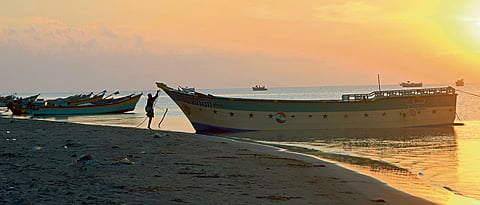

That house was once used by Prabhakaran, the LTTE chief and his men,” the young officer bragged pointing towards a small ruined house as we looked down from top of the 45 m high Kodikkarai lighthouse that towers over the landscape of Point Calimere Wildlife and Bird Sanctuary.
I was at Kodikkarai, the south-eastern tip of Cauvery River Delta in Nagapattinam district of Tamil Nadu where the Palk Strait meets the Bay of Bengal. Internationally known as Point Calimere, the name dates back to 16th century when the Portuguese established trade connections with the Chola kingdom.
The blinding sun shone relentlessly high up on the blue canvas of the cloudless sky by the time we reached Point Calimere post a boat ride at Muthupet Mangrove Forest. Bordered by the sea, the sanctuary has three natural habitats — the mangrove, wetlands dotted with salt pans and dry evergreen forest also known as Vedaranyam.
It is here at Vedaranyam that the endemic species of black bucks breed and graze. Created in 1967 for conservation of black buck antelopes, the sanctuary is spread over 377 sq km and is also wintering ground for migratory birds. But when I reached the sanctuary, the harsh sun had driven most animals deep in the forest seeking shade except the brown fur feral ponies that sauntered lazily. Untamed for being born in wilderness, the ponies were descendants of once domesticated breed of horses.
Later in the evening when we returned, the sun had lost its fury and was painting the sky with milder yellows and oranges. A gentle breeze ensured our bumpy ride in a rusty jeep remain comfortable. But there was no sign of black buck or any other wild animal even though we had covered a considerable distance. Just when I was getting disappointed, the naturalist pointed to a pair of spotted deer far in the bushes. But before we could blink and marvel at their glistening golden coat, the agile and ever alert pair had darted behind thicker shrubs.
Further down the trail, a family of wild boars loitered about grunting merrily but there was no sign of the dominant breed of the forest. Jackal, the only predator in these forests, would make its presence felt later in the evening, the naturalist informed us.
As we trundled along, some animal sped across the road. Black bucks at last! There were quite a few grazing in the dry grass landscape. A pair here, a loner there and few were hiding in the thorny bushes with only their antlers peeping out. Unlike spotted deer that venture closer to humans sometimes, the black bucks were wary of human presence and stayed away from the trail. They remained aloof, raising their heads once in a while to ponder whether we posed a threat to them. They did not shy away but held our gaze gauging, judging and then literally ignoring us.
The sun had dipped further and distant chirping of birds returning to their abode could be heard. We planned to return again early next morning for a rendezvous with migratory birds. Promptly at the break of dawn we made our way towards the sea beach where we were told dolphins could be sighted. As village fishermen prepared for the day, we did spot some snouts of playful dolphins but they remained elusive. We were, however, rewarded with bird sightings.
The flamingos had already migrated back home a little early. We spotted a lone Brahminy kite sitting atop a fishing pole and a lone painted stork sat rummaging in the muddy soggy patch. On our way to the marshy spot where we had spotted a congregation of common stork and black headed ibis the previous day, we came across another swamp teeming with Russian spotted greenshank.
Stoked at having seen a variety of wildlife, we headed to the ruins of the brick lighthouse built by Chola kings but the devastation during 2004 tsunami had left just a hint of the ancient structure. What caught my eye, however, was a puddle of sea water full of mudskippers, an amphibian fish. A little further stood the 13 m high British lighthouse built in 1890 that still functions as a beacon.
The morning was turning warmer. The birds began their search of food. The sanctuary naturalist advised us to head back as those feathery visitors would return only to the shaded woods. As if having heard him, another set of winged guests, a colony of seagulls, flew in a hurry a little ahead of us. I struggled to capture their flight. The birds hovered and rewarded me by settling down on a dry spot.
Back at camp a bulbul chirped in the shade as the sun blazed urging me to return to my cooler shelter too.
ST READER SERVICE
-Nearest airport is Tiruchirapalli and nearest railway station is Nagapattinam
- A modest forest department rest house, Flamingo House, can be booked by contacting wildlife warden at Kodikkarai. Trichy has much more options for boarding and lodging.
-The sanctuary remains open from 6 am to 5 pm all year round.
-Core of sanctuary is inaccessible to vehicles. However, forest department guide with prior permission from warden can take visitors to the core.
